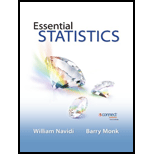
Concept explainers
The following table is a life table, reproduced from the chapter introduction. With an understanding of some basic concepts of
United States Life Table, Total Population

Source: Centers for Disease Control and Prevention
The column labeled ‘‘Proportion Surviving’’ gives the proportion of people alive at the beginning of an age interval who will still be alive at the end of the age interval. For example, among those currently age 20, the proportion who will still be alive at age 30 is 0.99050, or 99.050%. We will begin by computing the probability that a person lives to any of the ages 10, 20,…, 100.
The first number in the column is the probability that a person lives to age 10. So
The key to using the life table is to realize that the rest of the numbers in the ‘‘Proportion Surviving’’ column are conditional probabilities. They are probabilities that a person is alive at the end of the age interval, given that they were alive at the beginning of the age interval. For example, the row labeled ‘‘20–30’’ contains the conditional probability that someone alive at age 20 will be alive at age 30:
In Exercises compute the probability that a person lives to a given age.
1. From the table, find the conditional probability P(Alive at age 20 | Alive at age 10).
Want to see the full answer?
Check out a sample textbook solution
Chapter 4 Solutions
Essential Statistics
- A marketing agency wants to determine whether different advertising platforms generate significantly different levels of customer engagement. The agency measures the average number of daily clicks on ads for three platforms: Social Media, Search Engines, and Email Campaigns. The agency collects data on daily clicks for each platform over a 10-day period and wants to test whether there is a statistically significant difference in the mean number of daily clicks among these platforms. Conduct ANOVA test. You can provide your answer by inserting a text box and the answer must include: also please provide a step by on getting the answers in excel Null hypothesis, Alternative hypothesis, Show answer (output table/summary table), and Conclusion based on the P value.arrow_forwardA company found that the daily sales revenue of its flagship product follows a normal distribution with a mean of $4500 and a standard deviation of $450. The company defines a "high-sales day" that is, any day with sales exceeding $4800. please provide a step by step on how to get the answers Q: What percentage of days can the company expect to have "high-sales days" or sales greater than $4800? Q: What is the sales revenue threshold for the bottom 10% of days? (please note that 10% refers to the probability/area under bell curve towards the lower tail of bell curve) Provide answers in the yellow cellsarrow_forwardBusiness Discussarrow_forward
- The following data represent total ventilation measured in liters of air per minute per square meter of body area for two independent (and randomly chosen) samples. Analyze these data using the appropriate non-parametric hypothesis testarrow_forwardeach column represents before & after measurements on the same individual. Analyze with the appropriate non-parametric hypothesis test for a paired design.arrow_forwardShould you be confident in applying your regression equation to estimate the heart rate of a python at 35°C? Why or why not?arrow_forward
 Holt Mcdougal Larson Pre-algebra: Student Edition...AlgebraISBN:9780547587776Author:HOLT MCDOUGALPublisher:HOLT MCDOUGAL
Holt Mcdougal Larson Pre-algebra: Student Edition...AlgebraISBN:9780547587776Author:HOLT MCDOUGALPublisher:HOLT MCDOUGAL College Algebra (MindTap Course List)AlgebraISBN:9781305652231Author:R. David Gustafson, Jeff HughesPublisher:Cengage Learning
College Algebra (MindTap Course List)AlgebraISBN:9781305652231Author:R. David Gustafson, Jeff HughesPublisher:Cengage Learning Glencoe Algebra 1, Student Edition, 9780079039897...AlgebraISBN:9780079039897Author:CarterPublisher:McGraw Hill
Glencoe Algebra 1, Student Edition, 9780079039897...AlgebraISBN:9780079039897Author:CarterPublisher:McGraw Hill





